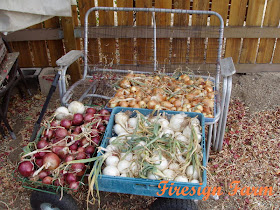The weather is supposed to start warming up again tomorrow, so it looks like I get one more lazy day before it's time to get my hands back in the dirt! I ordered my onion plants yesterday. Now, you could get onion plants from your local garden center, but most of them won't get their plants in for a few more weeks yet. I suppose I could grow my onions from seeds, but I've never had much luck starting, then growing them to a decent size inside. Besides, seed-grown plants should have been started in early January, at least. The little bags of onion bulbs, called sets, are ok if you want scallions or a few small onions for fresh use, but for big onions you want a variety specific to your growing environment. To get my onion plants when I want them, the varieties I want, for the way I want to use them, I've found it best to order them online. I've been very happy with the service and quality at Dixondale Farms.
Each leaf on an onion plant makes a layer inside the bulb. The earlier and quicker your onion starts growing, the more leaves on the plant and that means a bigger, juicier onion bulb. So they need a rich soil that will hold water, but with enough drainage to keep it from getting soggy. Drainage is no problem in my garden's DG (decomposed granite) sand, so I concentrate on supplying enough nutrients and water-holding capacity. Aries was out a couple of days ago running last fall's compost pile through the shredder, rebuilding the pile, and wetting it down. A check with the thermometer this morning showed almost no heating up though, so it's pretty much ready to use. I also have a bin of leaf mold, made more than a year ago, that's slowly broken down to a third of what it was. Leaf mold doesn't contain much nutrients, but it's great for water retention.
My onion plants should be shipped next week - they base shipping dates by your zip code to get your onions to you at the optimum planting time for your specific area. I know from experience that they will stay dormant for a few weeks if kept cool and dry, if the weather isn't cooperative. But looking at the advance forecast, it's time to get busy! The entire early bed gets a light dusting of my all-purpose fertilizer mix (equal parts bone meal, blood meal, and greensand), a layer of finished compost, plus some of the leaf mold. I'll just lightly dig that into the top six inches (I just leave it as a top dressing where the shallots and garlic are already up), and rake smooth. Onions, especially, don't do well in competition with weeds, so I then will wet that down well (or maybe Mother Nature will do it for me) to get any weed seeds in the top inch of the soil to germinate. Over the next week or so, a very light going over with the stirrup hoe a couple of times will take out quite a few baby weedlings before the onions go in.

Onions switch from growing leaves to swelling into bulbs depending on the amount of daylight during the height of summer. I live right where Nevada makes that obtuse angle next to California. Looking at the Dixondale map, that's intermediate day onion territory. But I want the storage capabilities of the northern, long day, onions. So I compromise by ordering long day, long keeping onion varieties and then get them into the ground as early as I can with as much soil fertility as I can so they can grow as many leaves as possible before mid-summer. I ordered one bunch of Copra, the biggest and best-keeping onion I've found. And then I ordered a mixed variety sampler bunch (since you get a price break ordering more than one bunch, but two bunches is all I have room for) of long day onions. The Walla Walla grow great here - they get really big really fast, but then don't store at all. We start pulling and using them by early July, for fresh use as we need them, so they're usually all gone by early September. If you're not interesting storing your onions, grow the Walla Walla. By fall, we're using the Ringmasters, for fresh eating and then that's what I use in my fall tomato sauce and salsa canning recipes. We pick a few Redwings incrementally throughout the summer, whenever I want a red onion, and then those also store well into mid-winter.
No comments:
Post a Comment